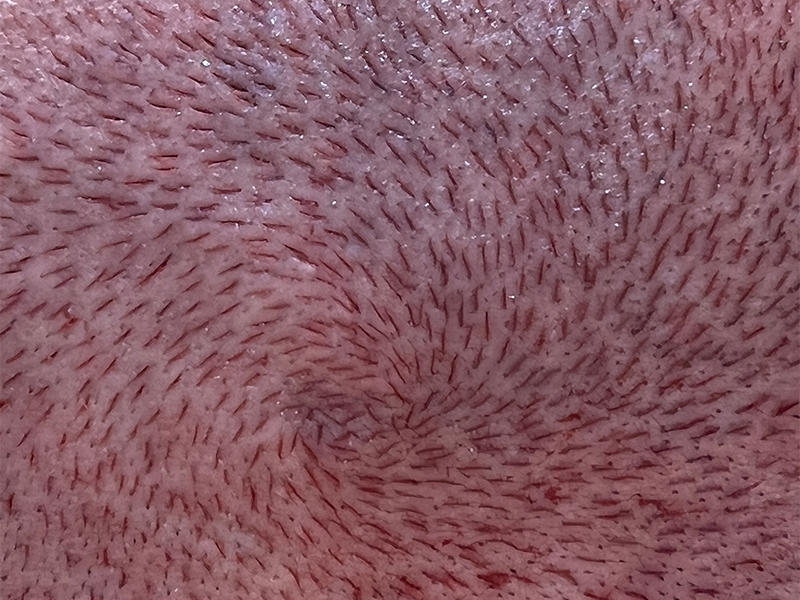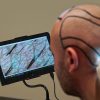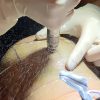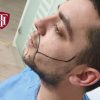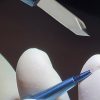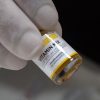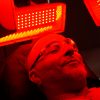Contents
360 degree vertex hair transplant (crown area)
In the hair transplant planning of the crown area, called the vertex, the directions of the channels are given in such a way as to create a “rose image” to obtain a natural image. In this way, whether the person has short or long hair, the natural look does not change.
The term ‘Vertex’, which is a term of Latin origin, means ‘higher area, summit’. In hair transplant, the term Vertex is used for the back of the head.
Although hair transplant planning is mainly based on the frontal part, it is essential to evaluate the crown to complete the aesthetic appearance. People who have hair loss problems on the crown will have a successful appearance in the front profile, but will have problems in the back and side profiles.

Vertex hair transplant
When it is about hair transplant, people often think of the front part. In male-type falls, the receiving zone is divided into 7 parts. However, these parts can be grouped into 3 main areas, the anterior, middle and posterior. While talking to people in daily life, looking in the mirror or taking pictures, the front part is mainly used.
Planning is done from front to back, since the area that gives people a profile is the part of the face and the complement of the face is the front part.
According to the situation of the donor area, if there is a large opening and the donor area is not enough to completely close the recipient area, planning is done for the front and middle parts. Vertex is left for a second session, which can be done after a minimum of 1 year.
Although the front area is considered more important than the apex when ranked in order of importance, the receiving area does not consist solely of the front area. For a natural image, it should accompany the frontal part to the crown part. Otherwise, while people have a strong profile from the front, they will have problems at the side or rear angle.
360 degree hair transplant / vertex hair transplant
Unlike the frontal part, the canal directions are 360 degrees in the implants to be made in the crown. The reason for this is to obtain the natural image. The person may have short hair over time. The hair directions at the crown do not bother the person if they have long hair, the 360 degree channel directions gain importance as the channel directions become more visible on long hair.
The holes where the grafts will be placed, called canals, have 3 different dimensions: right-left, up-down and depth. Since the thickness of the tissue at the crown is greater than in the front, this situation must be observed for crown implants and planning must be done well.
To get the rose (swirl) image on the vertex implants, the angles from right to left must be 360 degrees, while the direction structure from top to bottom needs to be adjusted. Otherwise, the grafts will remain on the surface and undesirable losses will occur due to the lack of feeding.

Things to Consider in Vertex Hair Transplant
Another important issue to consider when planning your crown transplant is the risk of continued falls. A Vertex hair transplant operation, to be performed in the early stages without considering the risk that the decay map may change, may become an unwanted look in the near future, although it makes the person happy in the first few months.
This is because the drop map has changed and the depopulation in the Vertex area has increased. In such cases, since previously transferred hair follicles will not be observed to fall out, the hair around them continues to fall out while the transplanted hair remains.
While the hair from the previous transplant remains in the middle, a ring-shaped gap is formed around it. That is called a ‘ponytail’ image among the people. In order to protect the person from such an unnatural appearance, the fall situation should be well analyzed at the planning stage and the person should be informed about the possible situations.
Planning of the second session in Vertex
In Vertex alopecia, the operation should be planned in 2 sessions according to the situation of the person’s falls, if there is a lot of depopulation, priority should be given to the frontal part in the first session. If enough grafts have been removed, crown hair transplant can be planned.
If enough grafts cannot be extracted from the donor site, Vertex should not be started, the operation should be completed gradually when Vertex is reached. In this way, the post-op image will give the impression that ‘there’s no problem at the front – the falls started from the top – it’s moving forward (but it won’t).
Since there are thousands of people who have no frontal loss problem and only have loss in the vertex area, the person gets a natural look even though the vertex is empty. This is the form of planning that will least bother the person with large bald spots.
At the end of a 1-year process, a second session operation can be planned again and back-to-front planning can be done. The crown is determined as the 1st zone and the first planning is done in this zone. If the donor area allows more grafts to be extracted, the front part can be reinforced with the remaining follicles.
Vertex hair transplant with beard extraction
As a donor area, the priority is always the nape area. The hair structure at the nape of the neck and the hair structure at the receiving area are the most compatible hair structures.
In cases where the donor area is insufficient, the area that can be used as an additional donor area is the lower part of the jaw, the beard. Apart from this, a hair transplant operation to be performed with body hair from another area will not give successful results.
The point to remember when using the beard as a donor site is that because the beard is in profile, it is an additional donor site, not the main one.
When this excessive stress is applied, an undesirable appearance can be presented in the profile that will bother the person, therefore, the density of the beard must be carefully analyzed in the extractions, the habits of use of the beard of the person and planning should be done considering the possibility of cutting the beard in the future.
No more stress should be applied to the beard due to the need for more follicles.
Although extracted beard roots are similar to hair follicles, they are slightly different in terms of structure. For this reason, the hair follicles extracted from the beard should not be placed in the front in a single area, but should be evenly distributed on the crown.
With planning done this way, extra density is gained from the roots of the beard, while at the same time, the different shape of the beard is camouflaged with the follicles taken from the nape area for a natural look.
The issue to consider is that the number of beard roots used in the recipient area should not exceed 1/4 of the number of follicles in the nape.
If the relationship between the number of beards and hair follicles used deteriorates, that is, if planning is done in the form of more beard follicles, the beard roots will be dominant and a beard image will appear in the recipient area. This situation continues to disturb the person.
Vertex Hair Transplant Post Process
The postoperative process in Vertex hair transplant is similar to the normal postoperative. The point to consider is the sleeping position. For safe sleep, you need to lie on your back with an inflatable pillow. The 10-day period after hair transplant is the attachment of the hair follicles to the tissue.
At this stage, the follicles are in the process of healing and can be displaced or eliminated in cases of friction or blow. Therefore, it should be protected from scratches and bumps for 10 days.
A neck pillow should be used to protect the recipient area during sleep for the first 10 days after the operation. Due to the structure of the neck pillow, the person will be more secure while sleeping. Although the use of neck pillows is more comfortable in frontal transplants, it increases the risk of rubbing the pillow with the implanted part above the head.
Therefore, it is safer to sleep with your mouth facing your chest during sleep. By using a neck pillow, the person can lie down better while lying on their back in bed. The point to remember is that no matter what angle you are at, your mouth should be facing your chest.
When will the result of Vertex hair transplant be seen?
The tissue of the vertex is different compared to that of the front. Its blood circulation is less and it is thicker. This situation directly affects the time of hair growth. While the hair at the front, which has nutrition, provides earlier growth, the hair follicles on the crown provide later growth.
Patients who have both the frontal and crown transplants may not see the crown increase in density at the same rate as the frontal over the 6-7 months. Usually, this situation creates anxiety in people, but this is an unnecessary worry. Over time, the intensity in the front will begin to show in the crown.
As the follicles on the crown do not have the opportunity to be nourished as much as the hair follicles on the front, the recommended post-operative care products are used in the crown transplant. The lack of nutrition of the follicles in the front and upper part can be solved with care products rich in vitamins that the follicles need, and these products are prepared according to the postoperative use of hair transplant.
Is the hair kept in the crown area?
Although the general opinion in Vertex hair transplant operations is that the success rate is low, this situation is changeable. It is true that hair loss can occur due to the thickness of the tissue at the crown and less blood supply compared to the front. However, this problem can be solved with postoperative support. Some postoperative support treatments are;
- Otolog treatment with stem cells,
- Steam infusion treatment,
- Application of mesotherapy,
- Capillar laser,
- Tracking kit.
With these supports, the problem caused by the thickness of the tissues and the slow circulation are eliminated. Although they have different principles of action, the main objective of all support treatments is to revitalize the follicles in the area where they are applied.
Vertex Hair Transplant Success Rate
Today, thanks to developing technology and growing experience, the success rate of hair transplant operations exceeds 90%. The success rate varies in direct proportion to the donor area and baldness, as well as the technique used and the experience of the doctor who will perform the operation.
The most important stage of the operation is planning. For the operation to be successful, first of all a good analysis must be made and the wishes, expectations, things to do and what can be done must be evaluated, and a plan must be prepared considering all these parameters.
Otherwise, what will be done is not in accordance with the person’s expectation and although a very successful operation is performed medically, it cannot be considered as a completely successful operation.
There is no single option in aesthetic operations. What one person likes, another doesn’t like. This is not because the situation is bad, but because of different aesthetic perceptions. In fact, the most important success criteria in cosmetic surgery is the mirror.
If a person doesn’t feel good when looking in the mirror, how successful they are in the operating room doesn’t matter. Plastic surgeries are not life-threatening and are usually done to make you feel better. That is why they must make the patient feel good.
Vertex Hair Transplant Prices 2022
The prices of the operation vary according to the date of the operation, the preferred package and the planning to be carried out. You can get detailed information about the current fees for the operation of the Vertex zone (Vertex) here.






